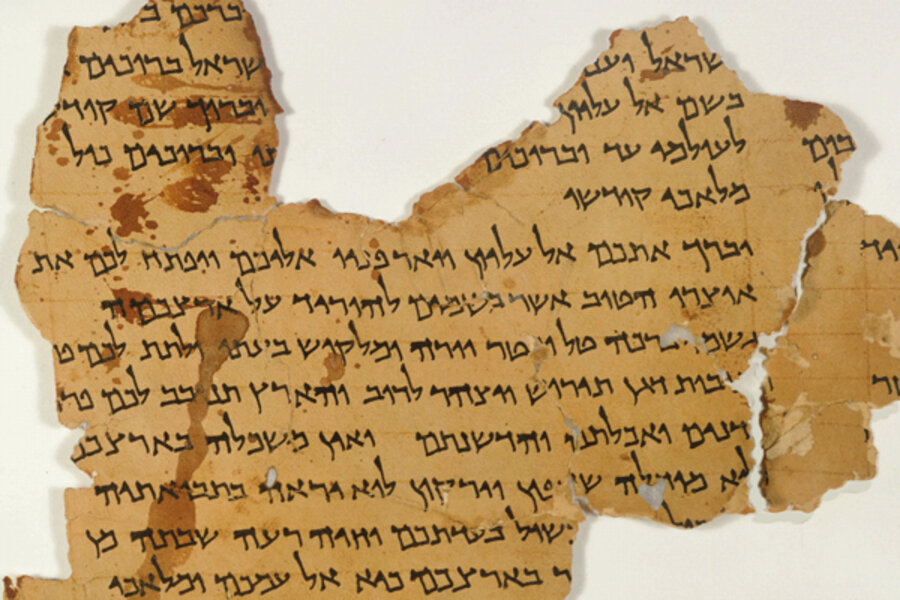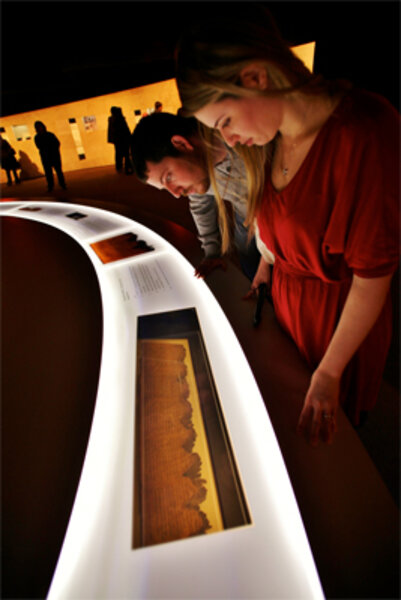Dead Sea Scrolls: The Boston exhibit lets visitors see one of the greatest treasures of the modern era
Loading...
A Bedouin goat herder was merely chasing after a stray when he stumbled into a cave and discovered one of the greatest treasure-finds of the modern era.
The ancient manuscripts inscribed in Hebrew dialects that he discovered rolled inside clay pots became known as the Dead Sea Scrolls, currently the oldest existing biblical manuscripts since they date from between 150 B.C. and 70 C.E. Now one of the largest public displays of the Dead Sea Scrolls ever is the centerpiece of an exhibit at Boston’s Museum of Science titled “Dead Sea Scrolls: Life in Ancient Times.”
“We are thrilled to bring this world treasure to Boston for the first time,” said Paul Fontaine, Museum of Science vice president of education. “The artifacts and rare texts [in the exhibit] offer a tantalizing glimpse of daily life in ancient Israel, a vital cultural crossroad. The scrolls offer a once-in-a-lifetime opportunity to understand the attitudes and aspirations of a people who lived 2,000 years ago and help us all appreciate a culture that continues to influence our own.”
The Dead Sea Scrolls contain biblical text found in the Hebrew Bible, or Old Testament, in addition to other books not included in the canon such as the Book of Enoch, the Book of Jubilees, and the Testament of Levi. Eleven caves eventually yielded 972 scrolls altogether in early 1947.
The Dead Sea Scrolls “provide a record of extraordinary human achievement,” said Dr. Risa Levitt Kohn, professor of religious studies at San Diego State University. “They teach us about our past and ourselves.”
The majority of the scrolls are nonreligious, Dr. Kohn said, and are comprised of commentary, legal documents, and references to the end times of the world. They reveal an ancient culture finding itself in the struggle between good and evil and provide “a spiritual map of ancient Israel,” she said.
Some of the scrolls have changed hands over the years and at one point, four of the scrolls ended up in the United States. A tiny ad in the Wall Street Journal published in 1954 hoped to bring forth a buyer: "The Four Dead Sea Scrolls: Biblical Manuscripts dating back to at least 200 BC, are for sale. This would be an ideal gift to an educational or religious institution by an individual or group."
And they found one. In a clandestine operation using Prof. Harry Orlinsky, a religious scholar, as a middle man posing as “Mr. Green,” Israeli authorities bought the scrolls for $250,000 the same year.
Since then, the Dead Sea Scrolls have come to America several times, once in 1965 and intermittently since 1993. The most recent, according to the Israel Antiquities Authority, was the Minnesota Museum of Science's exhibit in 2010.
In addition to the fragments of the scrolls – some of which are the size of postage stamp – on display, the exhibit at the Museum of Science contains cultural artifacts, including a 3-ton stone from the southwest corner of the outer wall of the structure known as the Second Temple in Jerusalem. The stone is thought to have detached from the wall during the Roman fighting in 70 A.D.
There are also artifacts once used in ritual worship in homes such as a small clay incense altar, pottery rattles, and fertility symbols represented by female, dove, and pomegranate clay forms. Other items of note: a marble slab engraved with a menorah dating back to the destruction of the second temple and a coin presumed to be similar to the ones used by the money changers driven out of the temple by Jesus.
Exhibit goers can leave a note or prayer near the exhibit that will be sent to Israel.
“Dead Sea Scrolls: Life in Ancient Times” will be on display at the Museum of Science in Boston from May 19 to Oct. 20, 2013.









